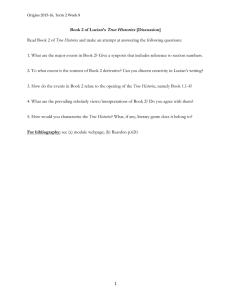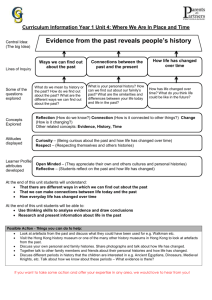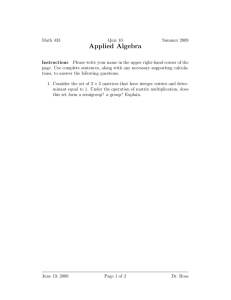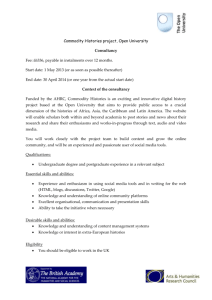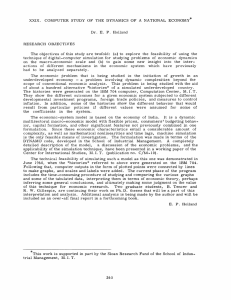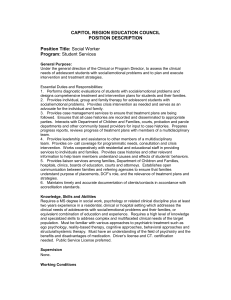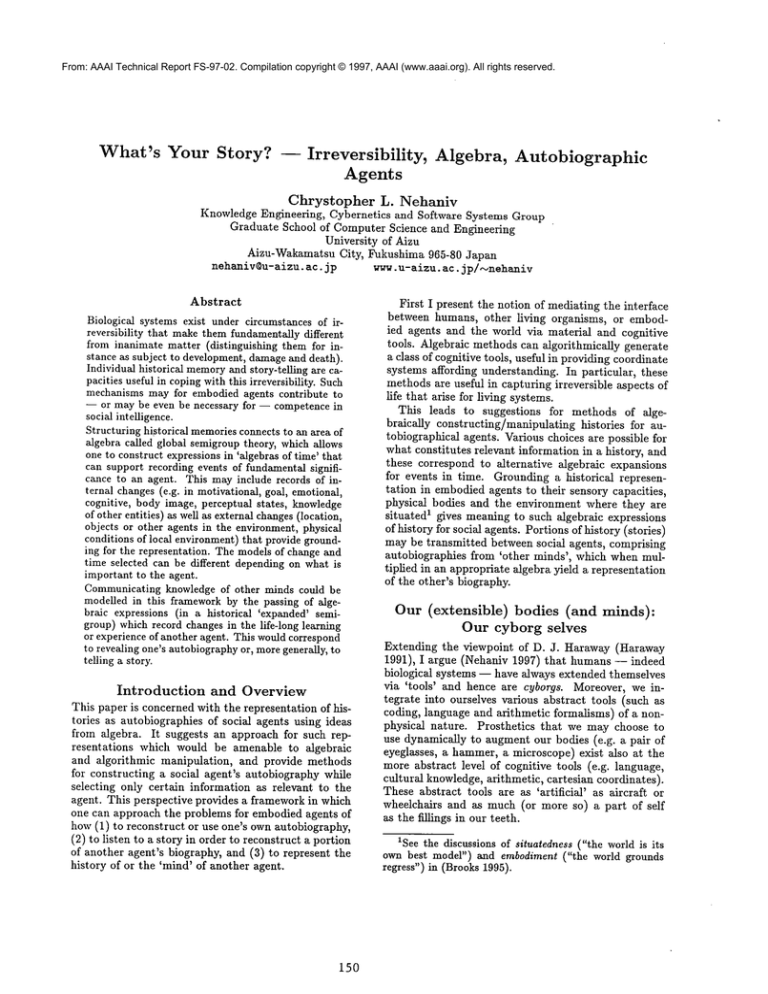
From: AAAI Technical Report FS-97-02. Compilation copyright © 1997, AAAI (www.aaai.org). All rights reserved.
What’s
Your Story?
--Irreversibility,
Agents
Chrystopher
Algebra,
Autobiographic
L. Nehaniv
Knowledge Engineering, Cybernetics and Software Systems Group
Graduate School of Computer Science and Engineering
University of Alzu
Aizu-Wakamatsu City, Fukushima 965-80 Japan
nehaniv~u-aizu,
ac. j p
~. u-aizu,ac. j p/~nehaniv
Abstract
Biological systems exist under circumstances of itreversibility that make them fundamentally different
from inanimate matter (distinguishing them for instance as subject to development, damageand death).
Individual historical memoryand story-telling are capacities useful in coping with this irreversibility. Such
mechanisms may for embodied agents contribute to
-- or may be even be necessary for -- competence in
social intelligence.
Structuring historical memoriesconnects to an area of
algebra called global semigroup theory, which allows
one to construct expressions in ’algebras of time) that
can support recording events of fundamental significance to an agent. This may include records of internal changes (e.g. in motivational, goal, emotional,
cognitive, body image, perceptual states, knowledge
of other entities) as weUas external changes(location,
objects or other agents in the environment, physical
conditions of local environment) that provide grounding for the representation. The models of change and
time selected can be different depending on what is
important to the agent.
Communicating knowledge of other minds could be
modelled in this framework by the passing of algebraic expressions (in a historical ’expanded’ semigroup) which record changes in the life-long learning
or experience of another agent. This would correspond
to revealing one’s autobiographyor, more generally, to
telling a story.
Introduction
and Overview
This paper is concerned with the representation of histories as autobiographies of social agents using ideas
from algebra. It suggests an approach for such representations
which would be amenable to algebraic
and algorithmic
manipulation,
and provide methods
for constructing a social agent’s autobiography while
selecting only certain information as relevant to the
agent. This perspective provides a framework in which
one can approach the problems for embodied agents of
how (1) to reconstruct or use one’s own autobiography,
(2) to listen to a story in order to reconstruct a portion
of another agent’s biography, and (3) to represent the
history of or the ’mind’ of another agent.
150
First I present the notion of mediating the interface
between humans, other living organisms, or embodied agents and the world via material and cognitive
tools. Algebraic methods can algorithmically
generate
a class of cognitive tools, useful in providing coordinate
systems affording understanding. In particular,
these
methods are useful in capturing irreversible aspects of
life that arise for living systems.
This leads to suggestions
for methods of algebraically constructing/manipulating
histories for autobiographical agents. Various choices are possible for
what constitutes relevant information in a history, and
these correspond to alternative
algebraic expansions
for events in time. Grounding a historical
representation in embodied agents to their sensory capacities,
physical bodies and the environment where they are
situated 1 gives meaning to such algebraic expressions
of history for social agents. Portions of history (stories)
may be transmitted between social agents, comprising
autobiographies
from ’other minds’, which when multiplied in an appropriate algebra yield a representation
of the other’s biography.
Our (extensible)
bodies (and minds):
Our cyborg selves
Extending the viewpoint of D. J. Haxaway (Haraway
1991), I argue (Nehaniv 1997) that humans -- indeed
biological systems -- have always extended themselves
via ’tools’ and hence are cyborgs. Moreover, we integrate into ourselves various abstract tools (such as
coding, language and arithmetic formalisms) of a nonphysical nature. Prosthetics
that we may choose to
use dynamically to augment our bodies (e.g. a pair of
eyeglasses, a hammer, a microscope) exist also at the
more abstract level of cognitive tools (e.g. language,
cultural knowledge, arithmetic, cartesian coordinates).
These abstract tools are as ’artificial’
as aircraft or
wheelchairs and as much (or more so) a part of self
as the fillings in our teeth.
1See the discussions of situatedness ("the world is its
own best model") and embodiment ("the world grounds
regress ’) ) in (Brooks 1995).
Mathematics shows that for any given circumscribed
finite-state
system and its transformations (whether reversible or not), one may obtain an appropriate coordinate system representation
(Krohn, Rhodes, & Tflson
1968). Such an algebraic coordinatization may serve as
a new mental lever for understanding the given system
(Nehaniv 1996). Descriptions of the necessary techniques and examples including how the decimal expansion, encodings in clock faces, coordinate systems for
understanding symmetries of regular geometric figures,
and conservation laws in physics can be derived in this
way may be found in (Nehaniv 1997).
Algebras
Probably as early as Aristotle, philosophers realized:
Time has the property that event c following the two
successive events a then b is the same as b followed by
c and prior to both a. Thus events in time satisfy the
associative law (Nehanlv 1993): (ab)c = a(be). Structures satisfying this law are called semigroups. Unlike
the time of differential equations (which fails to be expressive enough for living systems), associativity gives
us a framework for myriad models of time, even if irreversible.
You can’t
Biological
Systems
and
Irreversibility
Erwin SchrSdinger (Schr6dinger 1944) in his inquiry
into the nature of living systems speculated that they
are analogous to ’aperiodic crystals’.
Such aperiodic
crystalline
properties have since been found in the
double-helical molecule of heredity, deoxyribonucleic
acid (DNA), which is at the same time both stable
and regular while providing the basis for encoding genetic variability.
Thermodynamically, living systems
maintain themselves while causing a stream of order
to come raining down on them, via their metabolisms,
at the expense of an irreversible global increase in entropy in their surrounding environments.
Finally each living thing is doomedto lose its individual battle against entropy. Manyirreversible events
2occur in the development of most biological systems.
Development is largely irreversible,
certainly very
much so for humans and other mammals. Damage
in the course of life may be mildly or extremely irreversible (scarring or the loss of a limb), as are other
changes (getting one’s adult teeth, development of secondary sex characteristics,
learning to read, or metamorphosis from chrysalis to butterfly).
And ultimately,
death, as the loss of homeostasis and maintenance of
the body’s barriers against the increasing entropy of
the environment, reveals a fundamental distinction between ourselves as embodied living beings and inanimate systems such as crystals,
chemical compounds or
3planetary systems following computable trajectories.
2It maybe surprising the someevents that would be irreversible for humanswould not be so for certain other creatures. For example, in Porifera (sponges), cells of the organism passed through a sieve can regenerate new sponges
(Gilbert 1994, pp. 28-29).
3The latter are amenableto formal description by differential equations in which one may recover previous states
of the system by putting in, say, a negative number for
a time parameter t. Such an approach is of course inadequate -- by the uniqueness theorems for differential
equation models -- if used for instance to attempt to recover prior courtship behavior of a bird sitting outside your
windowsill, or more generally in recovering previous states
whenthe current state could have resulted from any of several possible histories.
of Time and History
go back.
For example, in multiplying in the semigroup of numbers: 3 x6 ×0 x8 = 0× 15. The result is zero, no
matter what other factors were involved in the product. Knowing only the result (zero) does not allow
us to recover any other factors. Similarly, considering two dead insects zapped by an electrical bug killer
or two inhabitants of ancient Athens, one cannot recover their different histories or much else to distinguish them from their remains. The situation
would
be much improved if one of them kept a still extant
diary (or interacted with someone who did).
We’ll always
Memories
have
Paris:
Capturing
What exactly were you doing a year ago today? What
were you wearing? What did you eat? Without films,
photographs, historical
records, knowledge of this is
likely to be gone forever. However, some physically invisible facts from the past are recoverable since they
are remembered. By keeping track of histories
of a
calculation or a life, much more than current state is
available. For example, a history of the left hand side
above is: 3, 18, 0, 0 while on the right we have 0, 0 as
two stories of partial products when calculating from
left to right. For a living organism, a record of special irreversible state transitions beginning with the
start of life and ending with death provides a selective narrative:
hatch from the egg, pupate, narrowly
escape being eaten by a bird. In fact for any semigroup, the set of possible (in a fixed representation)
histories themselves have an associative multiplication
structure. Thus the set of possible histories itself com4prises an expanded algebraic structure.
Note that the decimal expansion of the real numbers
also encodes a history of how to obtain the number.
For example, 1.9999.. and 2.000.. describe very different paths to the number ’two’: "Take one and ninetenths and nine one-hundredths and ..2 vs. "Start at
two and take zero and zero and zero ..." It is worthwhile to remark that even here in arithmetic we have
two histories for the same result)
4The current state can be recovered from the history,
which is thus literally an expansion of the present state.
5Also observe that the irrational numbers are exactly
151
Even in learning a simple vocabulary describing the
actions in environment from another agent, a social
robot can never have exactly the same observational
perspective as its teacher, so it would be useful to remember at least enough history to attempt to transform the perspective
of the teacher to that of the
learner. A concrete example of the difficulties
in an
a-historical learning of such a vocabulary is presented
in (Billard gz Dautenhahn 1997).
Expansions:
Different
Views
of Time.
The choice of what to remember in the history is by no
means unique. For example in the products of numbers
above, we get different histories if we record, the partial products from left-to-right,
right-to-left (choosing
a direction for time), or record all the factors (among
manyother possibilities).
Newtonianhistories consist of records of all instances
of physical time and associate events that occurred at
each. Such a notion of historical
time is somewhat
bizarre from the perspective of living systems for whom
only especially important events may be relevant, and
so ultimately probably it will not be of great interest
for them or for use in other embodied agents. This realization about individual relevance of events is closer
to Freud’s notion of intense or traumatic events as
determinants of an individual’s character (birth, typical event sequence yielding Oedipal complex, first sex,
marriage, loss of parent, ...), which comprise the elements of a Freudian history.
Other notions of history may include records of reflections on the past events or future events (applicable
in planning, but also in neurosis), and so on. These
different sets histories all correspond to semigroup ex6pansions used in algebra.
The semigroup for possible events in the life-history
of a robot or organism varies strongly with the structure of the entity and its sensory, perceptual and other
capacities.
Given a semigroup, expansions are uniform ways of enlarging the semigroup into another one
whose elements include formulaic encodings of historical information about events possible in the semigroup.
It is thus possible to expand various heterogeneous
semigroup structures in the same way, e.g. Newtonian
histories can be constructed for two physically radically
divergent entities.
While global semigroup theory, and in particular expansions, are a recently developed area of mathematics
that is only slowly finding its way into applications in
the inanimate natural sciences, it seems clear that it
those whose historical (decimal) expansion representations
never repeat in eternal cycles.
6The most well-known of these is the Rhodes expansion, whichis useful in complexity theory and records irreversible transitions as one reads the events from most recent
to longest ago, while essentially ignoring reversible events.
See (Tilson 1976) for its construction, the multiplication
Rhodes histories, and mathematical applications.
152
provides a language in areas where traditional
mathematics is inadequately mute. Namely, the sciences of
the artificial,
including design sciences, robotics, and
biology (especially evolutionary and developmental biology and ecology), exhibit a crucial historical and contingent nature. Here the fact of designed, evolved or
adapting interfaces to the world or to other entities or
to portions of the self, which could have been otherwise, indicates the need for a mathematical language
that can usefully formalize the notion of ’what happened’. We are not in Kansas anymore.
Autobiographic
Agents.
I define the concept o/an autobiographic agent as
an embodied agent which dynamically reconstructs
its individual ’history’ (autobiography) during its
lifetime.
-K. Dautenhahn (Dautenhahn 1997b)
-Now instead of purely reactive systems controlling
our synthetic social agents (whose ’mind’ may be described as a single state with little analyzable structure
and no historical information), the foregoing discussion
reveals that algebra provides various options in replacing simplistic states by expanded ones which include
history of the agent elaborated in a particular
way.
On-the-fly construction of the histories is possible for
many of the expansions. A history can serve as an
element of an algebraic structure, but also as an autobiographical portrait of what is important to the agent
about itself and of how it got the way it is.
Depending on the available
sensory/perceptual
modalities, representation
of motivation, goals, or
’emotional’ state in a social robotic agent, one can
choose an algebra for time and an expansion for history in which the agent could compute during its experience or re-construct from memories autobiographical
information in an appropriate algebraic system. Furthermore, agents ~ith varying capacities,
endowments
and experience may use different historical algebras.
Prospects:
Stories
of Other Minds
Such autobiographies could of course be communicated
to a human or artifact social agent. Furthermore, the
algebraic structure on histories means that one has algorithms to build-up computed histories from successive portions of history. That is, elements of a formal
algebraic story may be multiplied by a receiving agent
to yield a history of the sending agent. Such an approach may provide insight into the representation by
social agents of other minds, which has been suggested
as a fundamental pre-requisite for social intelligence;
while autism is hypothesized by many researchers to
indicate a failure to construct empathic representations
7of other mlnds.
7See (Dautenhahn 1997a) for a survey and thoughtprovoking discussion of the issues of other minds as related to socially intelligent agents, and somepossible cog-
Acknowledgement
Other minds may or may not suffer
from some
pathology, e.g. neurosis can result from overactive attempts at constructing histories that take many past
events and possible future events into the account; in
the extreme case, the present could be lost from consideration in spite of the fact that the agent effects
actions only in the present.
Implementing historical
representation
in autonomous agents (e.g. robots) and the challenge of usefully relating histories between agents of the same or
varying "kinds remains a future prospect. Forthcoming work of K. Dautenhahn and the author focuses on
the realization of historical representations, motivation
and emotional states, and their communication (storytelling) in appropriate coordinate systems between situated agents.
This paper reflects our early attempt at outlining
how one might exploit algebraic methods in autobiographic agents. Technical details of the semigroups
and appropriate historical systems based on them will
depend on the characteristics
of the agents who are to
make use of them. In future work it should be possible, for example, (1) to test and compare the efficacy
of different mechanismsfor recording histories (different coordinate Systems arising from various semigroup
expansions of the agent’s possible transitions) such as
Newtonian, Freudian, Rhodesian, other or dynamically
varying historical
systems in embodied social agents,
(2) to compare, for various problems, autobiographic
agents to reactive a-historical agents who process only
the immediate context and a (minimal) state to select their actions, (3) to allow evolutionary emergence
of choices for how to select, encode and decode historically relevant information, (4) to study communication
of histories as they are constructed (hearing an autobiography as it develops) between robotic agents which
may be using the same or different representation for
their own autobiographies as their social partners are
using, (5) to build artificial societies of story-telling
robots ~dth similar problems to solve and to study
the evolution of emerging cultural information and the
agents’ social construction of meaning, (6) to study
possible social pathologies transmitted via story-telling
in a culture of embodiedsocially intelligent agents, and
(7) to study how story-teUing influences polymorphism
of social roles and ontogeny of communicating agents
(see the discussion of (esp. third-order) structural coupling in (Maturana & Varela 1992)).
s
I am indebted to Professor John L. Rhodes of the University of California at Berkeley for the deepest part
of an unusual mathematical education. The realization
that semigroup theory is related to history comes from
him. It is pleasure also to acknowledge Dr. Kerstin
Dautenhahn of the University of Reading for stimulating discussions and inspiration.
References
Billard, A., and Dautenhahn. K. 1997. Grounding communication in situated, social robots. In Proc. "Towards Intelligent Mobile Robots" TIMRUK97. Technical
Report Series of the Department of Computer Science,
Manchester University.
Brooks, R. A. 1995. Intelligence without reason. In Steels,
L., and Brooks, R., eds., The Artificial Life Route to Artificial Intelligence, 25-81. LawrenceErlbaumAssociates,
Inc.
Dautenbahn~ K. 1997a. I could be you -- the phenomenological dimension of social understanding. Cybernetics and
Systems 25(8):417-453.
Dautenhahn, K. 1997b. The role of interactive conceptions of intelligence and life in cognitive technology. In
Marsh, 3. P.; Nehaniv, C. L.; and Gorayska, B., eds., Proceedings of the Second International Conference on Cognitive Technology) 33-43. IEEE Computer Society.
Gilbert, S. 1994. Developmental Biology. Sinauer Associates, Inc., 4th edition.
Haraway, D. J. 1991. A cyborg manifesto: Science, technology, and socialist-femini.qm in the late twentieth century. In Simians, Cyborgs and Women:The Reinvention
of Nature. Routledge.
Krohn, K.; RJaodes, J.; and Tilson, B. 1968. Chapters
1,5,7-8. In Arbib, M., ed., Algebraic Theory of Machines,
Languages, and Semigroups. Academic Press.
Maturana, H. R., and Varela, F. J. 1992. The Tree of
Knowledge: the Biological Roots of HumanUnderstanding. ShambalaPublications, Inc., revised edition.
Nehaniv) C. L. 1993. The algebra of time. In Proc. National Conf. Japan Soe. for Industrial and Applied Math.,
127-128.
Nehaniv, C. L. 1996. Algebra & formal models of understanding. In Ito, M., ed, Semigroups, Formal Languages
and Computer Systems, RIMS Kyokyuroku, volume 960,
145-154. Kyoto Research Institute for Mathematical Sciences.
Nehaniv, C. L. 1997. Formal models for understanding:
Coordinate systems and cognitive empowerment.In Proceedings of the Second International Conference on Cognitive Technology, 147-162. IEEE Computer Society.
SchrSdinger, E. 1944. What is Life? Cambridge University Press, reprinted 1992.
Tilson, B. 1976. Chapter XII: Complexity of semigroups
and morphisms. In Eilenberg) S., ed., Automata, Languages and Machines, volume B. New York: Academic
Press.
nitive mechanismswhosefailure maybe related to types of
autism: MechanismA provides for empathic ’resonance’,
that is a degree of ~empathic,bodily re-experiencing’ of the
(state of) others. Mechanism
B relies on this, but interprets
not only ’the immediate situation of a human, but [also]
his/her biographical context’, whichis usually not directly
visible, but comprises important re-constructed aspects of
the other individual’s history. Note that from an algebraic
viewpoint, mechanismB is analogous to an expansion (in
the mathematical sense) of mechanism A.
153

